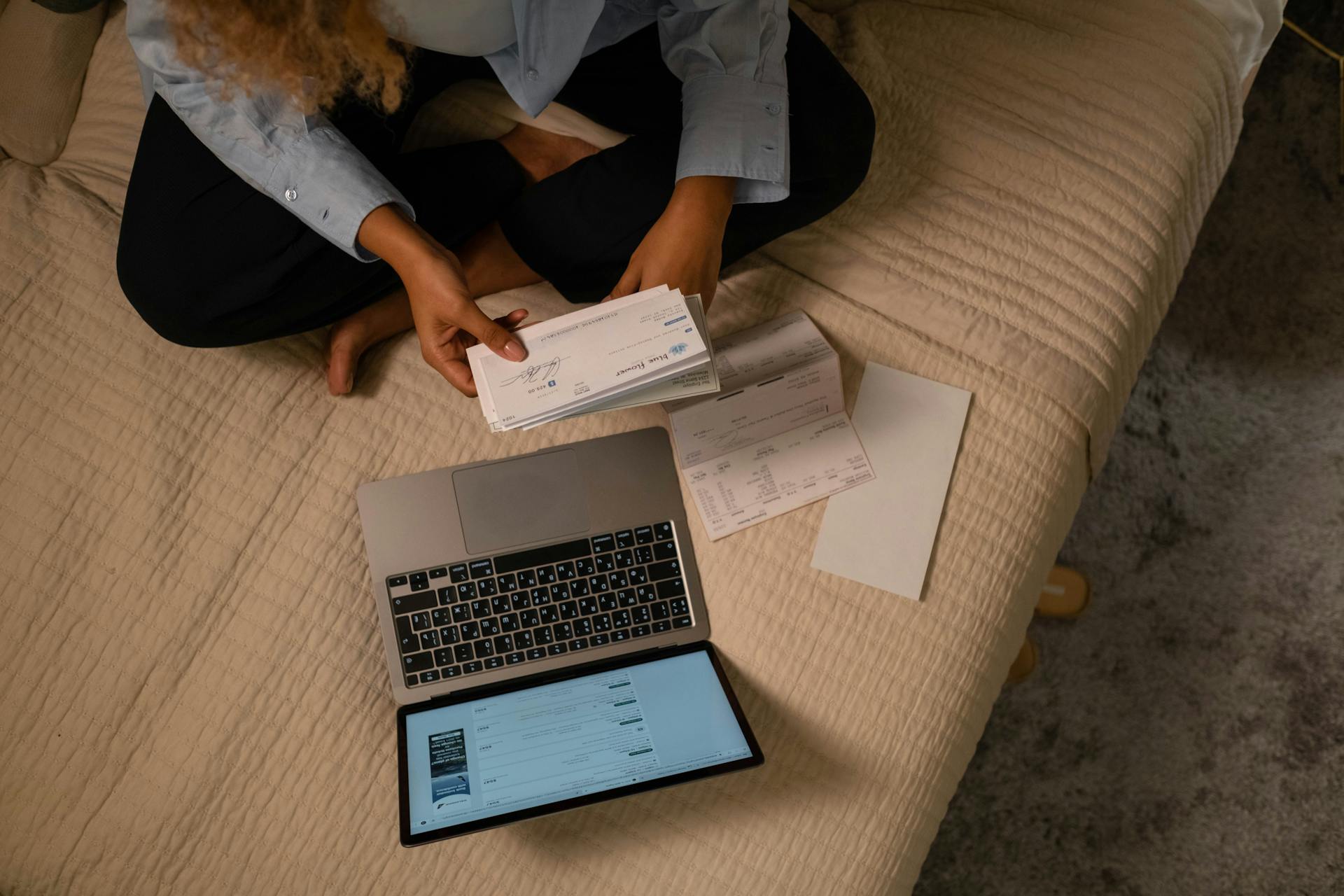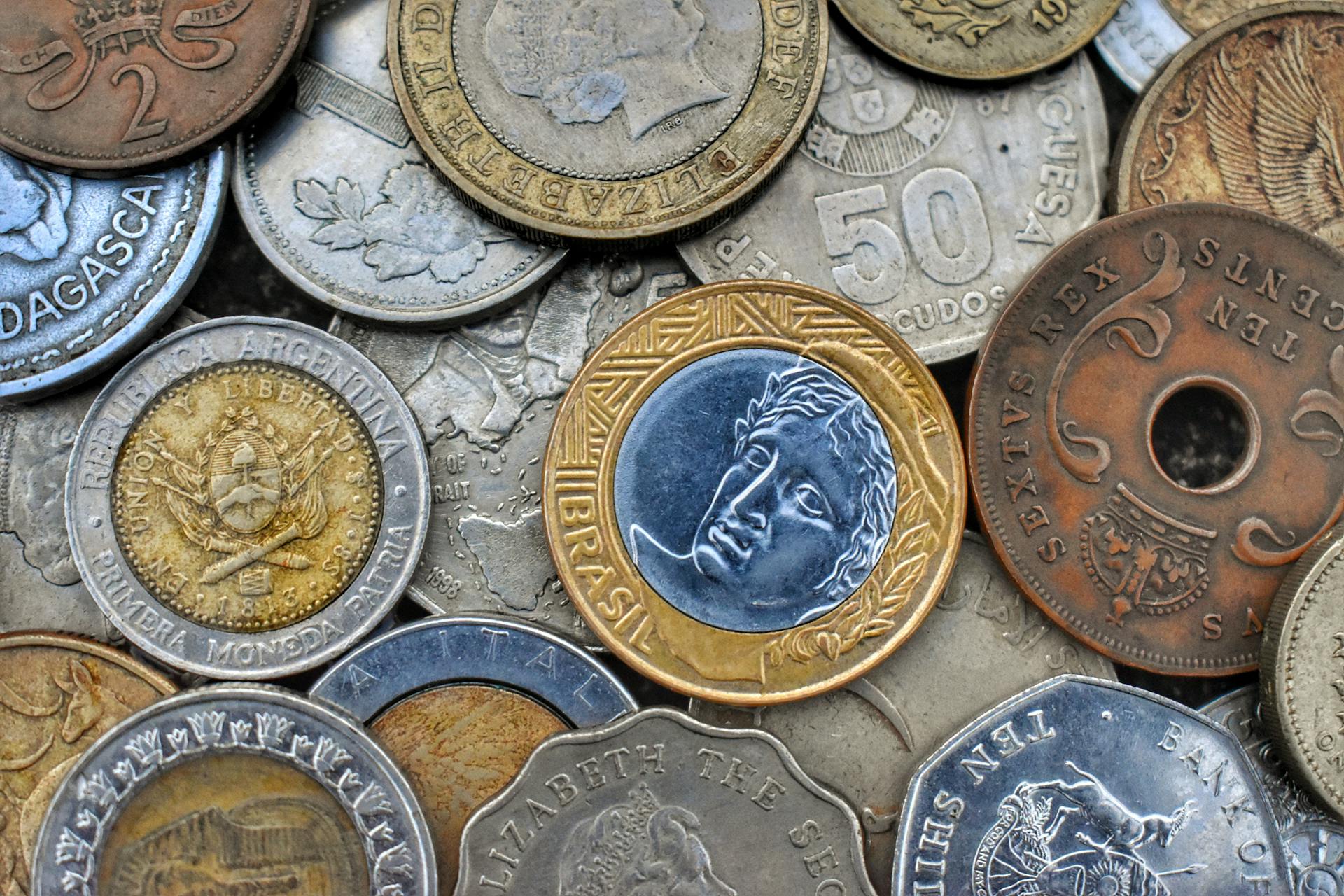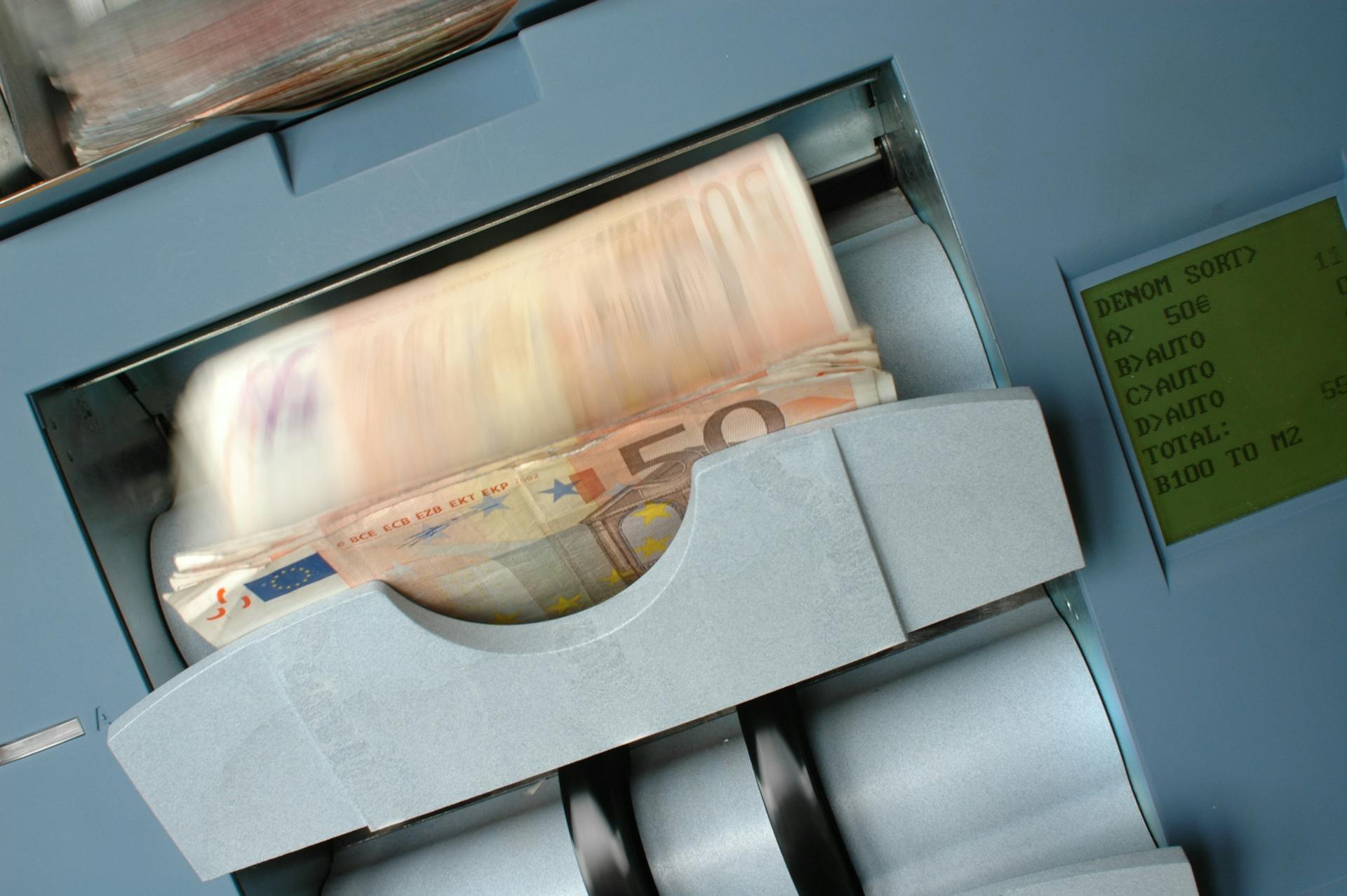
Traveller's cheques are a type of prepaid travel document that can be used for transactions abroad.
They're a popular option for travelers who want to avoid using their credit or debit cards while overseas.
Traveller's cheques are issued by banks and other financial institutions.
To get a traveller's cheque, you'll need to visit a bank or a travel agency that offers this service.
You can purchase traveller's cheques in various currencies, including US dollars, euros, and British pounds.
Check this out: Crossing of Cheques
What It Means
A traveler's check is a specialized kind of check that can be purchased from a bank or other financial institution, at an AAA office, or at other travel service offices in preset denominations.
These checks are often bought for use internationally and can be used to pay for hotels, restaurants, train tickets, souvenirs, and other purchases.
Each traveler's check is identified by a serial number, which is crucial in case the checks are lost or stolen.
You'll need to keep a record of the serial numbers separate from the checks themselves, so make sure to do that.
Traveler's checks can also be exchanged for the currency of the country you're in at banks and money-changing bureaus, although there's usually a small commission fee for this service.
You'll need to show your passport or other photo identification bearing the same signature as the one on the check when you use it to pay for something.
Each check should be inscribed with your signature on the specified line when you purchase it, and you'll also need to counter-sign the check on a different line to endorse it when you use it.
The signatures must match, and this is what provides security against lost or stolen checks.
Worth a look: What Vaccines Do I Need to Travel to Nigeria?
History and Background
Traveller's cheques have a rich history that dates back to 1772 when the London Credit Exchange Company first issued them for use in 90 European cities.
The concept of traveller's cheques evolved over time, with Thomas Cook introducing "circular notes" in 1874 that operated in a similar manner.
These early traveller's cheques were a game-changer for travellers, providing a safer alternative to carrying large amounts of cash.
In 1891, American Express developed a large-scale international traveller's cheque system to supersede traditional letters of credit.
American Express's introduction of traveller's cheques is attributed to employee Marcellus Flemming Berry, who devised a product that required a signature from the bearer.
The traveller's cheque system became one of the main ways people took money on holiday for use in foreign countries between the 1850s and 1990s.
Several brands of traveller's cheques were marketed, including Thomas Cook Group, Bank of America, and American Express.
Here are some key milestones in the history of traveller's cheques:
- 1772: London Credit Exchange Company issues traveller's cheques for use in 90 European cities.
- 1874: Thomas Cook introduces "circular notes" that operate in a similar manner to traveller's cheques.
- 1891: American Express develops a large-scale international traveller's cheque system.
- 1850s-1990s: Traveller's cheques become a main way people take money on holiday.
History
The concept of traveller's cheques dates back to 1772 when the London Credit Exchange Company first issued them for use in 90 European cities.

In 1874, Thomas Cook started issuing "circular notes" that operated similarly to traveller's cheques.
American Express developed a large-scale international traveller's cheque system in 1891, which was a significant improvement over traditional letters of credit.
The introduction of traveller's cheques was a game-changer for travellers, allowing them to carry funds in smaller denominations for more modest means, unlike the wealthy who carried letters of credit.
Several brands of traveller's cheques were marketed over the years, with American Express being the largest issuer by volume today.
A notable innovation was the invention of the modern traveller's check, which requires a countersignature, by Marcellus Flemming Berry for American Express in 1891.
The use of traveller's cheques became widespread between the 1850s and 1990s, as people sought safer alternatives to carrying large amounts of cash while abroad.
Here are some of the key brands that marketed traveller's cheques:
- Thomas Cook Group
- Bank of America
- American Express
More Detailed Information
American Express is the largest provider of traveler’s checks worldwide, and you can purchase them at their offices or many banks.
Traveler’s checks are issued by major companies like Thomas Cook, a British banking and tourism company, as well as Visa and MasterCard.
You can buy traveler’s checks in various currencies, including American dollars, Australian dollars, Euros, British pounds, and Japanese yen.
If you use a traveler’s check for a purchase that costs less than the check's denomination, you'll get your change in the local currency.
The merchant who receives a traveler’s check can redeem it by depositing it into their bank account, which is then settled with the issuer.
Traveler’s checks don't expire, so you can hold onto them indefinitely until you're ready to use them.
For banks, traveler’s checks are essentially an interest-free loan, as the purchaser gives them cash that they won't spend for a while.
Many banks issue traveler’s checks to their account holders without extra commission charges, but when they do charge a fee, it's usually between 1 and 4 percent of the check's value.
Here's an interesting read: How Much Dollars Can I Carry from Usa to India
How to Use a Traveller's Cheque
To use a traveller's cheque, you'll need to purchase one in the foreign currency you'll need for your trip. This gives the cheque its monetary worth, allowing you to use it like cash.
You can purchase traveller's cheques from major financial service institutions, banks, and credit unions. They come in fixed denominations and various currencies, making them a safeguard in countries with fluctuating exchange rates.
To use a traveller's cheque, endorse it with your signature, just like you would with a regular check. This is a crucial step to prevent anyone else from cashing it.
Traveller's cheques don't have an expiration date, so you don't have to worry about them becoming invalid after a certain period. They also don't contain personally identifiable information, eliminating the risk of identity theft.
To cash a traveller's cheque, you'll need to sign it again, which is part of the dual signature system designed to prevent unauthorized use.
Recommended read: Is There a Charge to Buy a Visa Gift Card
Alternatives and Options
American Express released the American Express Travelers Cheque Card in 2005, a stored-value card that serves the same purposes as a traveller's cheque, but can be used in stores like a credit card.
This card was discontinued in October 2007, but other financial companies have since issued similar stored-value or pre-paid debit cards that can be used like credit or debit cards at shops and at ATMs.
The Visa TravelMoney card is one example of these alternative cards.
Using a credit or debit card issued by a bank that works worldwide and charges low or no foreign exchange fees on purchases or ATM withdrawals is another option.
Prepaid travel cards, like the Visa and MasterCard options, can be used to get local currency from ATMs and make purchases with merchants, effectively eliminating the need for traveller's checks.
These prepaid cards are not linked to your bank account, which prevents anybody from draining your checking account if the card gets lost or stolen.
See what others are reading: Chequing Account Td
Some prepaid cards offer low ATM fees, technology that lets you operate like a local in foreign countries, emergency cash when you lose the card, and “zero liability” fraud protection.
However, prepaid cards can be expensive, so you need to compare fees against your other cards to decide whether or not a travel card makes sense.
For U.S. citizens living abroad for extended periods, maintaining checking and other bank accounts in the United States provides several advantages, and many checking accounts are friendly for foreign transactions.
On a similar theme: Visa Prepaid Credit Card
Benefits and Drawbacks
Traveler's checks have their perks. One major advantage is that they can be replaced if lost or stolen, providing peace of mind for tourists.
Traveler's checks are widely accepted around the world, making them a convenient option for travelers. They're also easy to use, as you just need to sign the check and have it cashed.
One of the best things about traveler's checks is that they don't expire, so you don't have to worry about them becoming invalid after a certain period.
Take a look at this: Best Capital One Transfer Partners
Here are some key benefits of traveler's checks:
- Replaced if lost or stolen
- Widely accepted around the world
- Convenient to use
- They don't expire
On the other hand, traveler's checks have some drawbacks. They're a bit outmoded, and it's not uncommon for people to question their usefulness in today's digital age.
You'll also need to have the physical check with you to use it, which can be a hassle if you're trying to travel light. And, to make matters worse, there's a fee to purchase traveler's checks, which can add up quickly.
Limited to a few issuers today, traveler's checks are no longer as widely available as they once were.
Where to Get and How to Cash
You can get traveler's checks from banks, currency exchange offices, and some travel agencies. I've personally picked some up from banks before a trip.
Some hotels, resorts, and currency traders will cash traveler's checks in exchange for local currency. However, with the rising prevalence of credit and debit cards fewer locations cash traveler's checks.
You can also try using traveler's checks to make purchases, as many merchants still accept them. Just be sure to sign them first to activate them.
Discover more: Post Office Travel Cash Card
Future of Traveller's Cheques
Traveller's cheques were once a staple for international travel, but their popularity has been declining in recent years.
In the past, traveller's cheques were a secure way to carry money abroad, as they were less likely to be lost, stolen, or forged compared to cash.
The first traveller's cheque was introduced in 1887 by Thomas Cook, a British travel agent.
By the 1990s, traveller's cheques had become a widely accepted form of payment worldwide.
However, the rise of credit and debit cards has led to a significant decline in the use of traveller's cheques.
In some countries, traveller's cheques are still widely accepted, but their use is becoming less common.
The American Express traveller's cheque, for example, was once a favourite among travellers, but it's now mostly used by those who prefer to avoid credit card fees.
Despite their decline, traveller's cheques are still a viable option for some travellers, particularly those who don't have access to a credit or debit card.
See what others are reading: American Express Travel Cheques
Sources
- https://en.wikipedia.org/wiki/Traveller%27s_cheque
- https://www.investopedia.com/terms/t/travelerscheck.asp
- https://www.encyclopedia.com/finance/encyclopedias-almanacs-transcripts-and-maps/travelers-check
- https://www.checkcity.com/personal-finance/what-is-a-travelers-check
- https://www.wikiwand.com/en/articles/Traveller's_cheque
Featured Images: pexels.com

